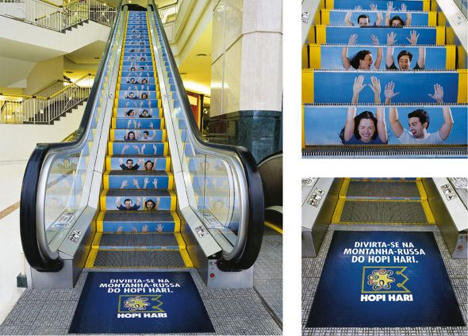Chapter one begins with a philosophical question: what is the purpose of advertising? While there are a million answers to that question in a hypothetical sense, the main purposes given by the book include public service advertisments (information campaigns for public benefit), cause advertising (for the purpose of fundraising), and commercial advertising (promoting consumption of certain products/brand, in terms of both the average consumer as well as other businesses). Each ad has its own specific purpose, in my opinion, but it's neat to know that there are reoccurring "families" that ads can fall into. Also, did anyone else notice how they just used a crappy low-res-google-image-search version of the VW ad on page 11? Or the typo on page three? I think they let the interns edit this edition of the textbook, because that many errors in so few pages is just silly (for a final product that we have to pay $40 for :))) My found image for this chapter is of an escalator ad, which used to be considered an ad-free space....no more!

Chapter 2: Six Phases of a Project
It looks like designers agree on six main steps in successful design (from start to finish). The stages, in my own words, look like this:
-Overview: meeting with a client and finding out what they want, how they want it, and why they want it. Background research relating to what you're thinking of doing for them also falls into the category of phase 1.
-Strategy: This is where client and designer make an agreement on what the designer is to make for the client, in a bit more specific way than "I can make your print ads." This is where everyone "gets on the same page", and plans of action are ironed out.
-Ideas: Now the specific design ideas are brought into play. The book notes the importance of having multiple ideas to let the client choose from, or perhaps several viable forms of the same idea. Creative solutions to the problems posed by the client in the first phase, coupled with the agreed-upon strategy of phase two, merge here.
-Design: This is the articulation of the best idea(s) from phase three. Many "rough" copies of the desired final product can be created along the way. Usually, the client will desire minor changes to the designs presented to them at this point.
-Production: Once the design has been finalized, it is time to actualize the advertisements in real life. Ie, manufacturing ad items such as printing posters or distributing the banner ads for use on websites.
-Implementation: Putting your ads out there for the consumer!! After they've been out there for a bit, it's wise to reflect on what did/did not work (debriefing).
This chapter reminded me of the learning triangle, which is automatically what I think of whenever flowcharts are around.

Ch 3: Creative Thinking
I found the morphological tool grid to be a little more confusing than just writing out all the permutations of solutions. If you had a whoooooole ton of options for each parameter, and you had a computer program you could use as a randomizer, maybe it would be helpful....but anyhow. I think that it's admirable to try and write about strategies of creative thinking, but it is very difficult to make these strategic processes "click" with a person in a meaningful way. Just because a person goes through the steps listed, does not mean the best design solution is going to be found. I thought it was neat to see so many seemingly-intuitive processes lined out in series of steps.
Image: I think that some people have a "step zero" to creative thinking, which is enhancing creativity or problem solving skills with drug use (including coffee). It might actually be a re-occurring step for some people. Here we have Mad Men lubricating their abilities with some mystery booze.

No comments:
Post a Comment